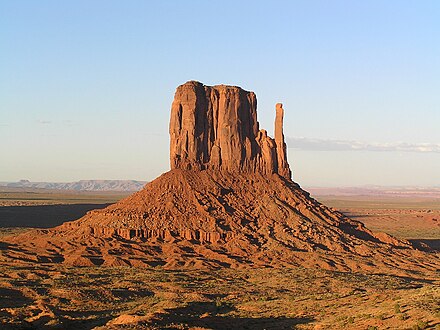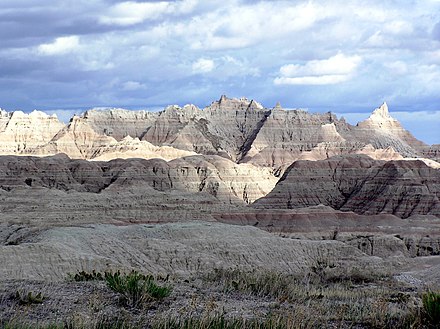Hiking in the United States
Hiking in the United States
Hiking in the United States is a good method of recreation in the country, and thanks to America's many open spaces, it is one of the best places in the world for hiking.
Understand

America's low population density compared to Europe, large number of national parks, and rugged country in the West and the Appalachians are major factors that have formed America's hiking opportunities that exist today. Particularly in mountainous regions, protected areas (such as National Parks) are often geared more to hikers than anyone else.
In America, hiking can be made more serious than it can be in all but the largest mountain ranges elsewhere. However, what many Americans consider to be a "hike" is often not very much. Meanwhile, there are other Americans for whom hiking is their main hobby, and they have the best hiking gear you could have.
If you're hiking in the United States, it's best to stick to the trails and not leave the path, especially in forested areas. One exception is some of the sand dunes in parks — because most sand dunes are covered by no vegetation, it is practically impossible to mark a path, and for that reason it will not be frowned upon to leave the path. In high-elevation deserts, however, you should not leave the path due to environmental concerns. The case is similar for grasslands and woodlands.
Prepare
Plan ahead before you get going. You should incorporate some flexibility in your planning when you're out there, but without a basic plan to guide you, things can go wrong very quickly.
Bring more water and food than is necessary for the amount of time you will spend. Know the climate of the place where you're going to hike, since there are many temperature extremes in the Western United States.
States have varying gun control laws; liberal states have stricter laws about carrying guns than conservative states.
Get in
Trails in the United States, particularly in parks, will begin at trailheads where there is a parking lot for cars (often unpaved), restroom facilities, and in many cases picnic tables and a water fountain. At the most-visited trailheads in parks, visitor centers can be found as well. Trailheads are starting points for trail networks, and because of this, many miles of trails can be found beyond, and they usually lead into wide open spaces. The farther from the trailhead you get, the poorer you can expect the route markers and signage to be.
If you can't or don't want to drive, getting to the trailhead can be a challenge. Some great hikes have bus access, but many don't. Taking a taxi to the trailhead is an option too, but make a plan for how to get back, bearing in mind that out in nature you may not have cell phone service.
Destinations
- Essentially all of the United States national parks have hiking opportunities. These will vary depending on the park. Trails will usually be shown on park maps.
- Reservations sometimes have their own parks. For example, the Navajo Nation operates tribal parks, including the famous Monument Valley Navajo Tribal Park. These parks have a lot in common with the National Parks, but don't have so many hiking trails. (For example, Monument Valley has hardly any hiking trails open to the public.)
- There are United States National Trails that are much longer than most of the ordinary trails; these "national trails" provide opportunities for hikes comparable in length to what people such as Lewis and Clark explored. Two well-known examples are the Appalachian Trail and the Pacific Crest Trail. In the U.S., you can also hike two of the longest hiking trails in the world: the American Discovery Trail from the west coast to the east coast, and the Continental Divide Trail along the Rocky Mountains from the Canadian border in Montana to the Mexican border in New Mexico.
- There are state parks throughout the United States that are managed by the state government instead of the U.S. government. They're often smaller and not quite as dramatic as the National Parks, but they provide a good idea of the countryside found in a region.
Some regions of the country have better hiking opportunities than others. The West has the open spaces, but at the same time it can also be dangerous due to wildlife, extreme temperatures, and the extremely low-density population of many areas.
Regional hiking articles
- Hiking in the East Bay — hikes east of the San Francisco Bay in California
Itineraries
Main article: United States National Trails System
- Ala Kahakai National Historic Trail
- Appalachian Trail — a U.S. National Scenic Trail that follows the Appalachian Mountain Range
- Arroyo del Valle Trail — short hike near Livermore, California
- Continental Divide National Scenic Trail
- Ice Age Trail
- Juan Bautista de Anza National Historic Trail
- Lewis and Clark National Historic Trail
- Natchez Trace National Scenic Trail
- Pacific Crest National Scenic Trail
- Ohlone Trail — crosses the ridges south of Livermore in California
- Oregon National Historic Trail
- Pony Express National Historic Trail — the Pony Express was once how mail was delivered across the country
- Santa Fe National Historic Trail
- Trail Of Tears National Historic Trail
Sleep
Because many of the trails in National Parks and even State Parks in some cases, are too long to finish in one day (and, of course, the same goes for the National Trails as well), you'll need to do some camping along the way. In many cases, parks will have camping areas, and if there are camping areas, go to those to camp. They will have more facilities, like restrooms, a place to start a campfire, and picnic tables.
If you want to stick to day hikes and therefore spend your nights in some form of lodging, hotel chains and smaller lodging agencies are widespread in the United States and you can expect at least some form of lodging near any of the reasonably popular national parks and any state parks that are near town/city areas. However, in some of the very popular parks like the Grand Canyon, you should book hotel rooms months ahead because everyone else is doing exactly the same thing.
Stay safe
Animal life
Main article: Dangerous animals
Safety is a major concern when hiking in the United States. Because hiking trails often lead into lonely areas, dangerous animals is a major concern. In the West and the Applachian Mountains, the dangerous animals include snakes, mountain lions, and bears; in the South, snakes and alligators are problems.
Snakes are small, and if you're in not in a forest and the trail is fairly wide, by being careful you can generally avoid snakes. By staying away from wetland areas, you will reduce your chance of having a dangerous encounter with alligators, since they are often found around the edges of ponds.
Mountain lions and bears are major problems, especially in the case of the grizzly bears found in the wilder parts of the United States.
Plant life
Watch out for poison ivy and poison oak, which can cause a nasty, itchy rash just by touching them, or even by touching clothing that has touched them. Poison ivy grows east of the Rocky Mountains; poison oak grows in the west. Both can be identified by remembering the rhyme, "Leaves of three, let it be." See Poisonous plants for more.
Water
Main article: Arid region safety
Whether you're in a dry part of the country or not, always bring water with you when hiking. Unlike in some parts of the world where hikers are never far from a town or city, in the United States many hiking trails are too far from cities or towns to make emergency calls possible. Therefore, bring the amount of water appropriate for the hike you are planning to do, and bring some additional water as well in case you get lost, especially if you're hiking in an area that you've never hiked in before.
The places where water is a really important issue are the desert areas and the regions of the country where population density is low. In at least some part of all the Western states, you can travel long distances without seeing any buildings whatsoever. Therefore, if you get lost and you don't have water supplies to last you at least a few days, you have a big problem. If you've never been to desolate areas, chances are high that despite reading the last few paragraphs, you may not understand what this means. Hopefully these pictures will give you an idea:
{|
|+
!
 !
! !
! |}
These are not the only places that are lonely. Imagine countryside as lonely as this across millions of square miles, and you have a better idea of how lonely the West can be, and how bad it can be if you get lost without water. Another enormous lonely area is Alaska — distances to civilization can be even longer than in the western continental U.S., but it's probably easier to find water.
|}
These are not the only places that are lonely. Imagine countryside as lonely as this across millions of square miles, and you have a better idea of how lonely the West can be, and how bad it can be if you get lost without water. Another enormous lonely area is Alaska — distances to civilization can be even longer than in the western continental U.S., but it's probably easier to find water.
Legal issues
Private property is very strongly protected under U.S. law, so be sure not to venture onto privately-owned land without the owner's permission, as this is regarded as trespassing, and could get you into legal trouble. In many areas, it is legal for owners to shoot people in defence of their property. If you need to take refuge on privately-owned land during an emergency, be sure to appropriately notify the owner.